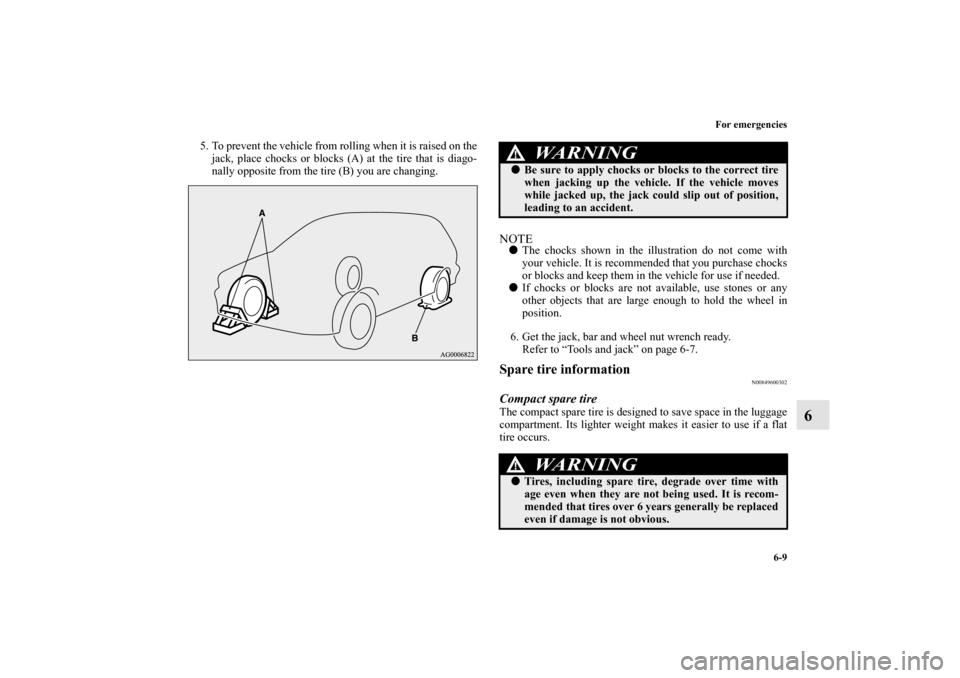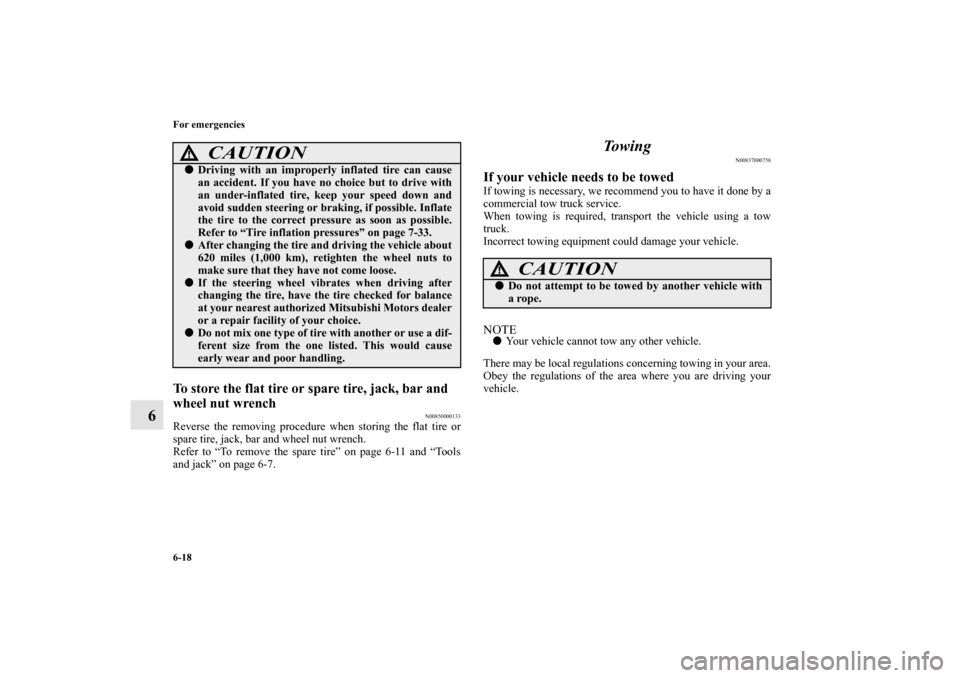Page 303 of 658
3-208 Features and controls
3
�Immobilizer is registered.�Refer to “Electronic immobilizer
(Anti-theft starting system)” on page
3-7, 3-43.
�The brake fluid level is low.
�There is a fault in the brake system.�Park the vehicle in a safe place and
contact an authorized Mitsubishi
Motors dealer or a repair facility of
your choice for assistance.
Refer to “Brake warning display” on
page 3-217.
�There is a fault in the Anti-lock brak-
ing system.�Avoid sudden braking and high-speed
driving, park the vehicle in a safe
place, and take corrective measures.
Refer to “Anti-lock braking system
warning light/display” on page 3-136.
�The tire pressure in one of the tires
(except spare tire) is low.�Refer to “Tire Pressure Monitoring
System” on page 3-153.
�There is a fault in the Tire Pressure
Monitoring System.�Refer to “Tire Pressure Monitoring
System” on page 3-153.
Screen type 1
Screen type 2
Cause
Do this (Reference)
BK0103001US.book 208 ページ 2009年8月20日 木曜日 午前10時45分
Page 395 of 658

4-4 Driving safety
4
Defrosters Check these by selecting the defroster mode, and set the blower
switch on high. You should be able to feel the air blowing
against the windshield.
(Refer to “Defrosting or defogging (windshield, door win-
dows)” on page 5-14, 5-24.)Tires Check all the tires for heavy tread wear or uneven wear pat-
terns. Look for stones, nails, glass, or other objects stuck in the
tread. Look for any tread cuts or sidewall cracks. Check the
wheel nuts for tightness, and the tires (including spare tire) for
proper pressures. Replace your tires before they are heavily
worn out.
As your vehicle is equipped with a tire pressure monitoring
system, there is a risk of damage to the tire inflation pressure
sensors when the tire is replaced on the rim. Tire replacement
should, therefore, be performed only by an authorized Mitsub-
ishi Motors dealer.Lights Have someone watch while you turn all the exterior lights on
and off. Also check the turn signal indicators and high-beam
indicators on the instrument panel. Fluid leaks Check the ground under the vehicle after parking overnight, for
fuel, water, oil, or other leaks. Make sure all the fluid levels are
correct. Also, if you can smell fuel, you need to find out why
immediately and have it fixed.
Safe driving techniques
N00629200078
Even this vehicle’s safety equipment, and your safest driving,
cannot guarantee that you can avoid an accident or injury.
However, if you give extra attention to the following areas, you
can better protect yourself and your passengers: �
Drive defensively. Be aware of traffic, road and weather
conditions. Leave plenty of stopping distance between
your vehicle and the vehicle ahead.
�
Before changing lanes, check your mirrors and use your
turn signal light.
�
While driving, watch the behavior of other drivers, bicy-
clists, and pedestrians.
�
Always obey applicable laws and regulations. Be a polite
and alert driver. Always leave room for unexpected
events, such as sudden braking.
�
If you plan to drive in another country, obey their vehicle
registration laws and make sure you will be able to get the
right fuel.
BK0103001US.book 4 ページ 2009年8月20日 木曜日 午前10時45分
Page 518 of 658

For emergencies
6-9
6
5. To prevent the vehicle from rolling when it is raised on the
jack, place chocks or blocks (A) at the tire that is diago-
nally opposite from the tire (B) you are changing.
NOTE�
The chocks shown in the illustration do not come with
your vehicle. It is recommended that you purchase chocks
or blocks and keep them in the vehicle for use if needed.
�
If chocks or blocks are not available, use stones or any
other objects that are large enough to hold the wheel in
position.
6. Get the jack, bar and wheel nut wrench ready.
Refer to “Tools and jack” on page 6-7.
Spare tire information
N00849600302
Compact spare tireThe compact spare tire is designed to save space in the luggage
compartment. Its lighter weight makes it easier to use if a flat
tire occurs.
WA R N I N G
!�
Be sure to apply chocks or blocks to the correct tire
when jacking up the vehicle. If the vehicle moves
while jacked up, the jack could slip out of position,
leading to an accident.WA R N I N G
!�
Tires, including spare tire, degrade over time with
age even when they are not being used. It is recom-
mended that tires over 6 years generally be replaced
even if damage is not obvious.
BK0103001US.book 9 ページ 2009年8月20日 木曜日 午前10時45分
Page 519 of 658

6-10 For emergencies
6
CAUTION
!�
While the compact spare tire is stowed, the inflation
pressure should be checked at least once a month to
assure that it remains at the recommended inflation
pressure. See the tire and loading information plac-
ard attached to the driver’s door sill.
Refer to “Tire and loading information placard” on
page 9-4.
�
Driving with an improperly inflated tire can cause
an accident. If you have no choice but to drive with
an under-inflated tire, keep your speed down and
avoid sudden steering or braking, if possible. Inflate
the tire to the correct pressure as soon as possible.
Refer to “Tire inflation pressures” on page 7-33.
�
The compact spare tire should be used only tempo-
rarily. While the compact spare tire is being used,
the tire pressure monitoring system will not function
properly. Have the tire replaced or repaired at an
authorized Mitsubishi Motors dealer or a repair
facility of your choice as soon as possible.
�
You can use the same wheel nuts on the compact
spare tire wheel.
�
Do not go over 50 mph (80 km/h) when driving with
the compact spare tire.
�
Avoid fast starting and braking when driving with
the compact spare tire.
�
Do not drive through automatic car washes and over
obstacles that could possibly damage the underside
of your vehicle. Because the compact spare tire is
smaller than the original tire, there is less clearance
between the ground and your vehicle.
�
Because the compact spare tire is designed only for
your vehicle, do not use it on any other vehicle.
�
Do not put the compact spare tire on a different
wheel, and do not put standard tires, snow tires,
wheel covers or trim rings on the compact spare
wheel. Otherwise, you could damage these parts or
other parts on your vehicle.
�
Do not use snow chain with your compact spare tire.
Using a chain could cause damage to your vehicle
and loss of the chains.CAUTION
!
BK0103001US.book 10 ページ 2009年8月20日 木曜日 午前10時45分
Page 520 of 658
For emergencies
6-11
6
To remove the compact spare tire
N00849700231
1. Lift up the board.
2. To remove the spare tire, remove the installation clamp
(A) by turning it counterclockwise.NOTE�
The clamp cannot be used for a normal size tire. Store a
normal size tire under the board.
NOTE�
Put the spare tire under the vehicle body near the jack.
This makes it safer if the jack slips out of position.
BK0103001US.book 11 ページ 2009年8月20日 木曜日 午前10時45分
Page 523 of 658
6-14 For emergencies
6
5. Remove the wheel nuts with the wheel nut wrench, then
take the wheel off. 6. Clean out any mud, etc. on the hub surface (F), hub bolts
(G) or in the installation holes (H) in the wheel, and then
mount the spare tire.�
The jack should not be used for any purpose other
than to change a tire.
�
No one should be in your vehicle when using the
jack.
�
Do not start or run the engine while your vehicle is
on the jack.
�
Do not turn the raised wheel. The tires that are still
on the ground could turn and make your vehicle fall
off the jack. CAUTION
!�
Handle the wheel carefully when changing the tire,
to avoid scratching the wheel surface.WA R N I N G
!
BK0103001US.book 14 ページ 2009年8月20日 木曜日 午前10時45分
Page 525 of 658
6-16 For emergencies
6
NOTE�
Flange nuts can be temporarily used on the compact spare
or steel wheel as shown in the illustration, but return them
to the original wheel and tire as soon as possible.
�
If all four wheels are changed to steel wheels, use tapered
nuts.8. Lower the vehicle slowly by rotating the wheel nut
wrench counterclockwise until the tire touches the
ground.
CAUTION
!�
Never apply oil to either the wheel bolts or the nuts
or they will tighten too much.
BK0103001US.book 16 ページ 2009年8月20日 木曜日 午前10時45分
Page 527 of 658

6-18 For emergencies
6
To store the flat tire or spare tire, jack, bar and
wheel nut wrench
N00850000133
Reverse the removing procedure when storing the flat tire or
spare tire, jack, bar and wheel nut wrench.
Refer to “To remove the spare tire” on page 6-11 and “Tools
and jack” on page 6-7.
To w i n g
N00837000758
If your vehicle needs to be towedIf towing is necessary, we recommend you to have it done by a
commercial tow truck service.
When towing is required, transport the vehicle using a tow
truck.
Incorrect towing equipment could damage your vehicle.NOTE�
Your vehicle cannot tow any other vehicle.
There may be local regulations concerning towing in your area.
Obey the regulations of the area where you are driving your
vehicle.
CAUTION
!�
Driving with an improperly inflated tire can cause
an accident. If you have no choice but to drive with
an under-inflated tire, keep your speed down and
avoid sudden steering or braking, if possible. Inflate
the tire to the correct pressure as soon as possible.
Refer to “Tire inflation pressures” on page 7-33.
�
After changing the tire and driving the vehicle about
620 miles (1,000 km), retighten the wheel nuts to
make sure that they have not come loose.
�
If the steering wheel vibrates when driving after
changing the tire, have the tire checked for balance
at your nearest authorized Mitsubishi Motors dealer
or a repair facility of your choice.
�
Do not mix one type of tire with another or use a dif-
ferent size from the one listed. This would cause
early wear and poor handling.
CAUTION
!�
Do not attempt to be towed by another vehicle with
a rope.
BK0103001US.book 18 ページ 2009年8月20日 木曜日 午前10時45分